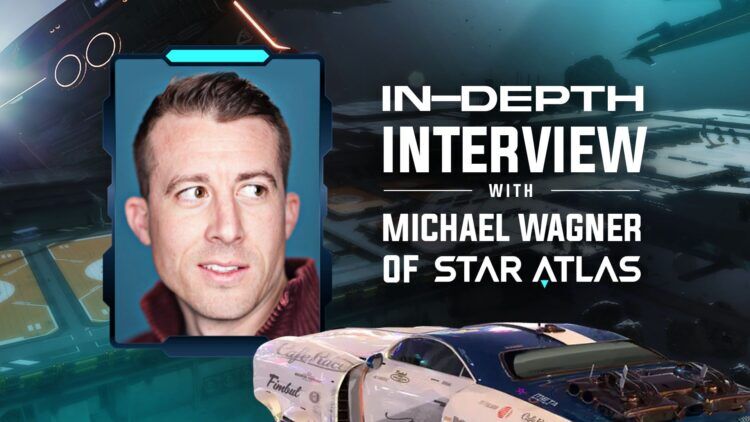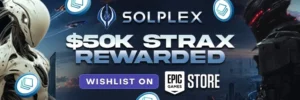Tell us a little about yourself, how did you end up as a Web3 Gaming CEO?
I am actually ex-finance. I hold a CFA charter, so I was involved in portfolio management and investment and securities analysis. The story that got me to Star Atlas really goes back to high school. I’ve said this often, but we had a computer group and kind of gaming group of friends back then. This is back in the local area networking (LAN) days. It was a really great group of friends. I still keep up with them 25 years later. I happened to be on a bike ride with one of the guys from that group, this was in 2013, and he was telling me about mining cryptocurrencies with GPUs.
We all had grown up building our own computers, and so I was like, this sounds brilliant, I want to try this out. Before I knew it, I just dove in head first, bought a bunch of GPUs and set up my own custom fabricated rigs, and I had this GPU farm all over my house and I was mining script coins.
The reality is this was late 2013, so as things were peaking and obviously 2014, 2015 weren’t great. That was kind of it, I got in through script coin mining, even though that was not a lucrative venture.
I was highly fascinated with the potential of the tech. And by 2015, I had quit the formal career and I just went full time crypto. Things started turning around and I really wanted to dedicate myself to this. I launched a company in 2016 operating at the intersection of Crypto and Cannabis. It is still around and has some notable success, but it was really through that company and an acquisition of a project called “Checks”, the Cannabis Hemp Exchange, that I onboarded Danny Floyd and Jacob Floyd, those are the two other co-founders and they have deep experience in game development. Danny in particular has over two decades of building AAA games, working on projects like Splitgate.
The pandemic hit and we were launching this tokenized closed loop financial system for cannabis in Nevada, and everything got put on pause. I went back to the drawing board and it was just Jacob, Danny and myself that were left at that company at the time, and I pitched them. NFTs were definitely hot, and gaming was, I would say, still on the rise. Axie was doing quite well, but we hadn’t seen any really high quality games.
And so the three of us sat down and came up with Star Atlas, and the rest is kind of history, but it’s been an incredible journey.
In your own words, how would you describe the vision behind Star Atlas?
In one word, I would describe it as massive. We know that this is an ambitious undertaking.
We are pulling it off. It obviously will take quite a long time. We know that this is going to take years, many years for us to accomplish. But I think our approach of delivering this content iteratively has been successful, and we’ve developed quite a lot and cultivated a phenomenal community. Broadly speaking, and maybe in the simplest terms, Star Atlas is a Space Simcade MMO. With that said, maybe getting more into the more complex terms, we do develop this across multiple environments, as I was describing. Unreal Engine we’re using UE5.2 right now. This is our flagship product, and probably the most attractive. It’s the hyper-realistic, cinematic quality graphics. This is the potential entry point to the metaverse, in our opinion.
Beyond that, we build in Play Canvas, which is a browser based application. This is a more real time strategy, still high quality 3D assets using WebGL, but just not quite as high fidelity as Unreal Engine. Then we have a mobile companion app that’s on the way.
Bigger than all of that really speaks to our philosophy and ethos around the integration of blockchain into what we do. Because from inception, it has been our ambition to integrate blockchain into virtually every element of Star Atlas. We’ve seen a lot of NFTs in games, and I think that’s a great step forward. But going beyond that, having things like the in-game currency being a crypto asset, digital currency that opens up the world of play-to-earn and then also having the governance structure through the DAO on top of it.
The most critical part of all of this is that we are abstracting game logic. We’re developing that through Solana on-chain programs or smart contracts and allowing the game logic to execute on-chain. We essentially are using Solana as our game server. Not exclusively. We still have game servers, but we’re allowing Solana to serve as a game server for us, which opens up this world of permissionless, composability or extensibility. We already have dozens of dApps that integrate into programs like Star Atlas because it’s all there and accessible on-chain. For me, I think this is incredibly synergistic and very valuable. It turns us into a platform where people can essentially mod our content.
They can create their own versions of Star Atlas, they can build their own products and services that tie directly into Star Atlas. For the developers of these dApps, they have the potential to monetize their efforts if they provide a valuable service to our users. For the users, they get access to services that we just simply don’t have capacity to build right now. Like, think about all of the DeFi applications that can be built, lending and scholarship programs, and there’s ways to automate various actions and operations in the game. For us, as a studio, we’re thrilled to see people building their own services on top of Star Atlas because, again, we don’t have the capacity to build everything. It’s way too massive.
If we can recruit a global population of developers to build on Star Atlas as though they were building on an L1 protocol, I see all of these advantages for the users and for us. That’s the big picture: This open, composable ecosystem that extends Star Atlas beyond just the game.
As one of the most highly anticipated Web3 games in the industry, the community has placed a lot of expectations on Star Atlas. How do you handle this level of scrutiny and praise?
We feel the pressure daily. I think part of the experience of achieving the level of success that we have so far and understanding that it’s going to be significantly higher, I would expect there to be even more scrutiny in the future. It really is learning how to manage that scrutiny now. I think what plays to our advantage is we have always been open and transparent and communicative. That’s part of what has enabled us to cultivate this fantastic community. I am in our public Discord every day, chatting with people in the community, and people love that I don’t think of myself as a celebrity in any way, but the perception of, hey, the CEO is in Chat, hanging out with us in general. And the reality is I love spending time there too.
I think to some extent, the flip side of it is also having the confidence in ourselves to know that we do have the expertise in building what we’re building. And while there’s a lot of commentary on the sidelines as to what you should be doing, we are the ones that are ultimately developing the game at this stage. We have to have confidence in ourselves, and I have absolute confidence in our team. When you see the content that we do release, it’s mind-blowing. This is really pioneering work that we’re doing also outside of integrating bleeding edge blockchain tech, even the fidelity of the game assets.
What sets Star Atlas apart from the rest of the industry? As a studio, what motivates your team?
I think it’s just sheer quality for one, and two really speaks to that platform concept, ecosystem concept. There are very few teams who are actually building game logic on-chain. Beyond just that approach, we’re actually developing the infrastructure that makes it all possible to do this in real time as well. We’ve built a middleware MMO game server that we call StarComm. We built an SDK that we call the F-KIT. That is the first blockchain integration into Unreal Engine 5. And we built a Solana wallet. When you’re interacting with our marketplace or you’re loading your ships or accessing your account, it is through a wallet connected in-engine that’s never been done before. We built a blockchain caching and indexing service.
All of these things allow us to execute this game function in real time without latency, as if you were using a web2 game server.
It seems as though there are constant improvements in game development being announced, what is something that you are excited about when it comes to the status of development? Any teasers for the audience?
We have a ton coming out, the 2.1 release just happened. But I’m most excited about the 2.2 release that’s coming after that. I’ll just point to two game products for that and then also our in browser which we call SAGE – Star Atlas Golden Era.
We are starting with SAGE. We’re positioned to roll out something like six on-chain programs in the next release. This is when we start to truly activate the in-game economy. The extraction and production of resources, the crafting of items, and soon to follow would be the combat systems. It’s really exciting because this is the test bed for a lot of our on-chain logic.
The highlight of what’s coming in 2.2.?
We have a press release coming out on this shortly, so I won’t share any names, but the most exciting component is our user concurrency potential which is how many people can fit into a single server. We are positioned to break all records this year, even with the fidelity level that we have of achieving in the next test, 5000 concurrent users in a single instance and then by the end of the year, 30,000 plus concurrent users in a single instance. That to me is one of the most exciting pieces of tech that are coming out.
You have just launched “Never Alone” a social campaign for this year. Can you tell the audience more about this, and what will draw gamers to participate?
Never Alone is really cool! It’s an immersive social campaign and it is a mission and achievement system. This will run for the remainder of the year and it is intended to finish in December. It’s 4 independent missions and within those missions a number of different quests that a user can complete. That’s everything from attending our events like our Town Halls, to posting about us on social media, to producing video content. But for us, where it all ties together is that there are ways to complete quests by participating in the game releases that we have coming. We want people to get into the game, experience it, have some fun, maybe produce some content about that or share it otherwise!
That allows us to continuously have people coming back for all of these staggered Iterative releases that we have coming through the year. From the lore perspective, I think that the team did a phenomenal job at crafting the story behind this of Saand, the Punaab who gets discovered by some other adventurer after they crashed on a planet and he’s lost all of his memories.
Your objective in supporting him is to go discover his memories, and unlock those in the process. You are essentially earning Loot that is all playable in game and it ties it all together because you can earn Loot. You can play the next experience and produce some content.
Are there any expansion plans or features coming for the Showroom?
Yes, the Showroom that you’re experiencing now is a segment of what will become the MUD Central Space Station. There’s three different factions in the game. The MUD is the future of the human race, the ONI is a consortium of alien races, and then the Ustur are sentient android beings.
Those are kind of the three factions that are competing for these resources in the universe. And so the MUD Central Space Station is where the Showroom lives, and right now you’re only experiencing that.
But this expands out to the full Central Space Station in the future. And in fact, the 2.1 release already sees a considerable expansion of that map. It’s probably a 5 or 6x increase in the size of the Showroom in 2.1, and this gets even bigger. I don’t know what the hard number is, but maybe 20 times, 30 times what you see today in the showroom is what the scale of the showroom ultimately will be as the Central Space Station.
Is there a timeline for when players will be able to explore with their spaceships for the first time?
Yes, a big part of the 2.1 release is that we actually have all 49 available ships flyable in the Showroom now. Some of those are still rough gray box, as we say, so they’re not fully textured. They don’t have all of the VFX, they don’t have all of the SFX. But we have quite a few polished ships that are complete. Six in total that are completely finished. The rest of the ships are all importable, and they can be loaded through your wallet, and they can be flown in the showroom as well.
As a dominant voice in the space, where do you see Web3 Gaming in the next 6 to 12 months? What are your hopes for the industry as a whole?
I think this quote is probably quite relevant here, and I might misquote it, but it has something to do with the fact that we “significantly overestimate what we can accomplish in one year and significantly underestimate what we can accomplish in ten”
I’ll take a more conservative approach here. I think within six months we’re not going to see any drastic changes in the space. One year – more reasonable. But to our earlier discussion point, these high quality games do take quite a long time to develop. What I will say is I know specifically from conversations with the Solana Foundation and the Solana gaming team, that there are mainstream players that are exploring the space right now. These are your traditional AAA studios. Now, what are the implications of that? It’s hard to say.
How far do they want to go out on the risk spectrum of actually incorporating the new technology? They’re probably going to be dipping their toes in the water and will be doing something like adding NFTs to games, but I would say I doubt they go too much further than that. In one year? In three years, yes. In five years, yes.
The implications for us with this is one, it helps establish a solid reputation and credibility for on-chain gaming when you get the mainstream players doing it. I think we can flip this narrative because as we know, there is still a high degree of skepticism out there about crypto gaming being scams. We think we’re doing our part to change the narrative on that too, because we’re trying to do really high quality stuff.
Ultimately for us, as part of this composable ecosystem, is that we want interoperability. And so does that mean that opportunities will exist in the future for assets from these other studios to live in our universe and vice versa? Possibly. Are there economic tie-ins? Possibly.
I think that’s the most exciting thing. Establishing the credibility as a real thing with real potential and being able to educate that mainstream gamer on what the advantages are to true asset ownership, to play-to-earn, to composability, that’s the big move for me. I don’t think we’ll see it in six months, but 2024, we’ll see some more substantial improvements.
And what’s kind of nice about people trying to time it, at least from our perspective, is we’ve been through it. The founding team especially, we all have been in the space for about ten years each, and we’ve been building through it. We know what the end goal is and we know what the value proposition is, so we’ve been building through it.
For the people that are just looking to jump on the bandwagon, well, as soon as things crashed, they all hit the brakes and now they’re significantly behind the curve because we’ll be well positioned when markets do turn around, we’ll be well positioned to be best in class.
Is there anything else you would wish to share with the community?
One final point we didn’t touch on was our DAO is officially coming online in June, so we’re actually setting the foundational proposal. We call these PIPs – “Polis Improvement Proposals.” The first PIP is coming online in June, so anyone interested in taking part in governance around Star Atlas, that’s a good opportunity.
Our economics are also coming online and for the people that think play-to-earn is dead, I vehemently disagree. I still think that is part of the value proposition of on-chain gaming, and it’s not to suggest that you can just infinitely inflate your economy, but our economics team consists of PhDs.
We put a lot of thought into structuring a sustainable economy as we have since inception, and our economics are coming online. That earnings potential is coming online and I think that’s something worth getting excited about!







